Expedition to West Malaysia 2012
All travel reports are translated electronically although minor improvements are sometimes made.
Expedition to West Malaysia 2012
West Malaysia (Peninsular Malaysia): Johor Bahru, Mersing, Pulau Tioman, Malacca, Kuala Lumpur, Batu caves, Cameron Highlands, Taman Negara National Park (Kuala Tembling, Kuala Tahan), Jerantut, Perhentian islands, Penang.
Apart from the places that I visited, this report includes a wealth of practical information, such as for example transport from one place to another.
The characteristic things about Malaysia:
►Malaysia is divided into eastern and western, and I assure that someone who was only in one part should not think that he knows all Malaysia well. Both parts are not only natural but also economically and culturally. Traveling from Western Malaysia to East Malaysia is a completely new adventure.
►For clarification; In Malaysia there are many ethnically diverse peoples, but only Malay and ethnic Malays from Borneo are really Malaysian. Hindus and Chinese are Malaysian but not Malaysian, just as black or Muslim in Europe are not ethnically European.

►Malaysians are very proud of the natural beauty of their country and they have a lot to offer, and are confident that tourists will come back to them. After spending a month and a half in Malaysia I think they are right and have something to boast about.
►Malaysia is officially a Muslim country, although in the area of Borneo Catholics are the majority, and there are also Buddhists, Taoists and Hindus. Islam in Malaysia is described as mild although not as gentle as in Kazakhstan. There are still women and women bathing in clothes, but this is less common than in ultra-conservative countries. Citizens of Israel are excluded.
►Malaysia has in my opinion an advantage over neighboring Thailand, because the beautiful Malaysian islands are still empty while Thailand is crowded with tourists and very noisy. Here we can rest more from the people and closer to nature.
Introduction
I’ve been to Malaysia before but I was too short and it was an unplanned stay, which resulted when I arrived at Hat Yai (a small town in the south of Thailand about 3km from Malaysia). In 2012 I was well prepared for my expedition and spent a month and a half in Malaysia. I saw very well in Western Malaysia and Sarawak state in Borneo, but this country has so much to offer that I have traveled more of the national parks than I had planned in the beginning. Stan Sabah has just started and I plan to see this last Malaysian Borneo region in the coming years.
Johor Bahru
I came to Malaysia from Singapore, crossing the border in Johor Bahru. The formalities went through without problem and I got a free visa for 90 days. After arriving at the bus station I understood the huge gap between Singapore and Malaysia. The palm trees and exotic vegetation were great but the train station required renovation and there were holes in the road. Anyway, the women with head covered were helpful and Malaysia made a good impression on me.
Transport from Johor Bahru to Mersing
About 2h for RM 11,50. On the way I saw oil palm and other exotic vegetation. It was nice.
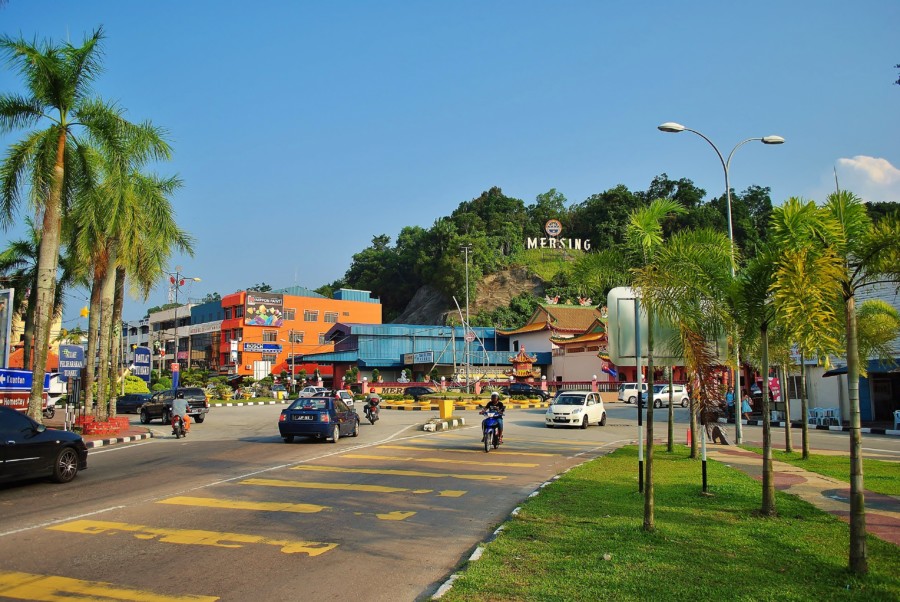
Mersing
This small town with good gastronomy is the base for the beautiful island of Pulau Tioman. Mersing is a good place to spend one night. There are ATMs, cheap internet and a wealth of cheap cafes. All Mersing went in an hour. I stayed here in Omar`s hostel for a very poor penny but would not recommend it. There was no mosquito net and I could not sleep. It was the worst night of the whole trip.
Ferry from Mersing to Pulau Tioman
Cruise took 2.5h for RM35 one way. Unfortunately, the transport to the islands is more expensive despite the small distance. On the way I admired the sea and the rocks rising from it.
Pulau Tioman
(Description of the natural beauty of the island and adventure of crossing the jungle)
Pulau Tioman is a beautiful, tranquil, almost deserted island, where extensive white beaches and turquoise, warm water can only be found. In the middle of the island there is also a jungle, which crossing is an additional attraction for ambitious tourists. I stayed in Air Batang where I had a small wooden house of very low standard for only RM30. Next to it was a pub near the beach where a couple of times visited me a big waran. It was a nice place to observe the sea horizon through the winding leaves of palm trees. With my feet, the tropical rain and the coconut in my hand, this moment was invaluable. I was surprised that such a paradise on earth has not yet become the object of White’s invasion, which in Thailand is rather impossible. For the first few hours I drank in the sea and watched the views. Then I went for a walk to the little Tekek village. I jumped from the platform and dived with a mask and a tube among the colorful fish. There was also a small raft from which I also jumped because Tekek is popular because of the shoals of colorful fish. Then I walked alone several kilometers further and through the palm trees on the beach and the statue of a great bellow, I reached the tree on which the great bats hung. I sat down on the beach again and again swimming in warm turquoise water. It was great! Then, walking through Tekek, I sat down in a pub under the palm trees and drank the coconut juice. In this way, I spent hours pleasing myself. In the evening, I met a nice French woman and went to dinner. Before I went to bed I picked up the mango from the tree and fell asleep at the sound of the waves.
The next day I went on a lonely expedition through the jungle along the sea to Monkey Bay. I went for a few hours and it was a very special experience because I was alone in the world of exotic trees with thick branches covered with lianas. Some of them were set on the rocks and there were also some spectacular grottoes, though I occasionally saw monkeys and heard the birds singing. It was hot and there was high humidity but the heat was on the leaves. One of the locals told me that the jungle was only passing 30% of the light from the burning tropical sun. On the way back I was swimming at dusk near Air Batang. This day was the most successful.

The next day I went to Tekek and from there I went to the biggest trek of Pulau Tioman. I went again for a lonely jungle trip, but this time to the other side of the island, to Juara beach. The whole tour was very adventurous as I was totally alone in the tropical maze. I had to squeeze through the boulders beside me, enter the woods that were sliding and follow the narrow paths. I also got water from the brook and had some monkeys to compose. The jungle on Pulau Tioman Island was wonderful. So far I have been to many beautiful beaches all over Asia but the jungles and caves are much more pleasing to me. When I got to Juara Beach I ate dinner with two young Swedish women who joked with me a little. It made them very happy because they were alone, and then I said goodbye and after dark I came back through the jungle to Tekek. This time it took me 4 hours and 3 hours. On the way the torch stopped me, so I had to flash the camera.
The next morning I went to the jetty at Air Batang and sailed to Mersing. My time at Pulau Tioman was very successful. Many bypass this island because of lack of time and go to Perhentian, but of course this is a big mistake. Pulau Tioman is quiet and peaceful and one of the best islands I have been to.
Transport from Pulau Tioman to Malacca
First 2.5h by boat to Mersing for RM35, then 4h bus for RM22.
Malacca
Malacca is one of the largest ports in South East Asia, which was once a fixed point on the trail of spices. For tourists, however, Malacca is a small but very attractive cultural and historical site whose sights you can see walking around the city. There are, among others, Chinatown and Little India and a colonial part where the Netherlands “meets” with Portugal. Malacca is full of attractive buildings from many Asian and European cultures, but there are also attractive bridges and a river where you can arrange a cruise. In my opinion, Malacca is culturally one of the most attractive cities in Malaysia, which should not be missed.
When I got to the main station in Malacca I went for a good dinner first and then got on the bus and RM1 got into the center. I slept in the Samudra Hostel for only RM12 per night overlooking an attractive mosque that looked more like a Buddhist temple. The hostel was very good although there were many beds in one room. The only RM12 was included breakfast and satellite TV for long evenings. For most of my stay in Melaka I had a very nice young German who had been traveling around this part of Asia for many years and had a tour of the monuments.

First, I walked through the main streets of Chinatown, Jln Tun Tan Cheng Lock (Hareen street) and Jln Hang Jebat (Jonker street). This area is an old part of the rich Baba, the Chinese born in Malai. There used to be antique shops here, but nowadays the well-kept historic houses have bakery and tea shops and restaurants. This is a very noisy place where there is always a lot going on and there are loads of goods for the richer and the poorer. Whilst in Malacca I was also on Friday and Saturday so I was lucky because I also saw a night market called Jonker`s Night Market. There was a lot of ingenious cooking and homemade baked goods and juices sold on the street, but also Chinese traditional food and goods stores. There are also some interesting shops and temples of different religions. One of them is the chedi Cheng Hoon Teng, built in 1646. It is an impressive temple built in typical Chinese style, with statues of Buddha and profiled roofs and exotic plants. All materials for its construction were imported from China.
In the second part of the city, the Unesco protected unofficial Dutch square, which houses the famous Stadhuys, dating back to the 18th century and one of the oldest Dutch buildings in Asia. It has a dark pink color and on the square in front of it there are many rickshaws, souvenir dealers, and a small windmill surrounded by flowers. There are many good places to take pictures not only of objects but also of people. In Stadhuys there is the Historical Museum, the Ethnographic Museum and the Museum of Literature. In general, all these museums concern Malacca. One tells the history of Portuguese, Dutch and British colonization, and Malacca’s rule during the reign of the Japanese. There are maps, European colonists in national costumes of those times, or even very impressive models of Portuguese war ships. The next museum shows us the Malacca culture, the Malay folk and the Chinese merchants, and how Malacca has changed over the centuries. Up there is also the Islamic Museum, but I’m not a fan of this religion. I have noticed that in many Muslim countries, the government is trying to force Islam to be tourist even though it is not pleasant. Stadhuys is definitely a must for Malacca. Next to it, also in the same color is the Church of Christ built in 1753. From the part of the Dutch Malaccca I went a little higher up to the Portuguese part. At the very top is the Church of St. Paul built in 1521 by a Portuguese captain. The church itself is not complete, but the historic walls still stand. There is also a statue of St. Paul, an art gallery on the air, and the fact that the church itself is located at a strategic point from which there is a nice view of the countryside. Down below is the Porta de Santiago, a ruined Portuguese fortress built by the Portuguese in 1511. This is a very nice looking object, and next to the shade of palm trees are also two cannons. There is also a museum in the ship and a bazaar. My German friend took me upstairs to the Chinese cemetery, and then strolled to Malacca watching the monuments and exotic vegetation. I liked the thick, big trees and massive roots and lions, and the river with small bridges and the slowly rotating Eye on Malaysia. The German took me to breakfast for Little India for rice and a cup of lobster. All my time in Malacca is very good and I would highly recommend this place. In my reportage I described only some places, but I want to point out that Malacca is full of interesting sights, temples and old shops. There is also very good cuisine and good and cheap hotel facilities. For those interested in Malay culture and products, I recommend Villa Sentosa, although similar places are also in other parts of Western Malaysia and Singapore.
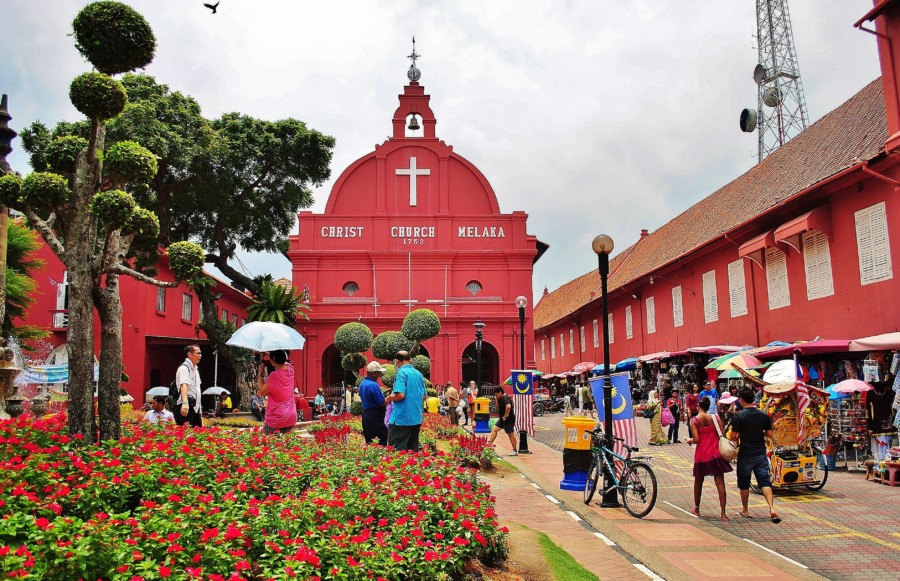
Transport from Malacca to Kuala Lumpur
The transportation was fast and hassle-free. For a 2h drive I paid RM9,20. From Melaka to Kuala Lumpur is 150km.
Kuala Lumpur
(Exact description of the city, transportation and its most interesting places in such a way that future travelers do not get lost in this city)
Kuala Lumpur is the capital of Malaysia and the largest metropolis in the country with a population of about 1.5 million people. This is a city where modernity meets the culture of Malaya, China and India as well as the United Kingdom. KL as it is commonly known, houses famous landmarks such as Petronas Towers and Menara KL Tower. Kuala Lumpur is also a city of good cuisine and also of beautiful nature. There are many wonderful parks, which puts KL in the forefront of the greenest cities in South-East Asia. Kuala Lumpur also has a very good transport, which is the underground and underground railways, which reach everywhere the tourists want to go. Many interesting facilities are located about half an hour walk from each other so you often do not need to ride considering that your base is in Petaling.
Upon arriving in Kuala Lumpur I first went to Masjid Jamek station, where you can see the popular mosque of the same name. From there I drove another stop to Pasar Seni. Here I got off and passing by the well known bazaar on Petaling street I reached the cheap hostel, where for bed I only paid RM15 per night. I did not visit the first day. I just walked around town with a friend from Spain generally looking at the city until we reached the gate of the Bird Park and the Butterfly Park. It was closed but the entrance cost RM50, too expensive. Very impressed me a great nature. There were great palm trees of many kinds, banana trees with characteristic large leaves and many colorful exotic flowers. When the Spaniard was gone, I sat down under palm trees for a portion of mango and then went to see the Independence Monument. It was a large concrete square with many fountains, and at the central point was a monument of armed men holding a Malaysian flag. The property is about 20-30 mins walk from Merdeka Square, but in my opinion the beautiful vegetation is worth more attention than the monument itself. On the first day I noticed that Kuala Lumpur is proud of its country and exposes the great Malaysian flags on its skyscrapers. On the margin in ultra-correct political England it would be rather forbidden because the leftist regime would say that “it would offend the foreigners.” In the evening I sat in the Indian district for a chicken masala and then went to fruit on Petaling. It was a successful day in the capital of Malaysia.

For the next two days I saw Kuala Lumpur well and returned to the best places. Generally each time it was a nice experience, and I must admit that since 2004 when I was here last time nothing changed. Maybe except that I saw some black, which means that soon may not be so safe anymore.
Anyway, here are the most interesting places I’ve seen in Kuala Lumpur:
In Chinatown:
►Jln Petaling; It is the most popular bazaar in Kuala Lumpur and well known among tourists, located in Chinatown. There are fake clothes and perfumes of branded companies and many pubs with food. The choice is huge and the presence here is a good experience. Open from morning to night.
Next to Petaling Market is the attractive Sri Mahamariamman Hindu temple and Chinese cafes. The temple itself is worth a visit because it has beautifully made, colorful Hindu figures of saints and for those who are unfamiliar with this culture it is of course getting to know something new. Across the street is an Indian restaurant serving chai and good chapati.
In Little India:
►Leaving from Chinatown where I lived, I reached the Mosque of Masjid Jamek built in 1907. I am not a fan of Islam, but I admit that Masjid Jamek is a very nice place, given that mosques will remain in Malaysia. Masjid Jamek has some not very high minarets and is built in large part without the walls of brightly red bricks.
This mosque is also decorated with attractive entrances and rounded onion-shaped roofs. This mosque is next to the LRT Masjid Jamek station.
►Masjid India street is just like Petaling in Chinatown, where you can shop and indulge in Indian style. Feel curry and masala spices and look at saris and turbans.

In and around Merdeka Square:
►Merdeka Square also known as Liberty Square. It was here in 1957 that the British flag was removed for the first time and the flag of the independent Malaya was founded. I will add that the mast to which the flag is attached is 100 meters long and it is the highest in the world. In the middle of the square there is a cricket pitch, ie Padang and Selangoror club. It is a building that once served as a meeting place and as a cricket club. In the British era, Merdeka Square was used for games and sporting events, and today it is home to many exhibitions, cultural and sporting events. Merdeka Square is in close proximity to the river and mosque Masjid Jamek, whose prayers are sometimes heard in the square. The Sultan Abdul Samad building of 1897, designed by a colonial architect whose many buildings are also in Singapore, is definitely worth a visit. This property is a mixture of Indian and Muslim style and Gothic and other western influences. I think it is one of the most interesting buildings in Kuala Lumpur, and the blending of architectural styles is evidenced by the fact that, on the one hand, the roof dome is typical of the Islamic style and the clock tower is European in style, yet it is finished with an Islamic dome. The mentioned clock tower is 41 meters long and is also called Malaysian Big Ben. During colonial times this building was intended for government offices and today it is the seat of the highest court and one of the most important landmarks in Kuala Lumpur.
On the other side of the street, you could not miss the large white building and the National History Museum. The museum is a “nice refreshment” because it is free, and speaking seriously gives it a chance to get acquainted with the historic Malay heritage from ancient times through the Sultanate of Melaka and colonial times to the present day. For example, when I was here in 2004, in addition to the costumes and handicrafts from the space, I saw a sandstone 250 million years ago and a fifteenth-century eight-sided gold coin. Personally I liked the human skull most 40000 years ago. In 2012, the exhibition was aimed at showing the modern Kuala Lumpur, and the most memorable I have come across is the large mock-up of KL city and numerous models of the best known KL buildings. The entire Merdeka Square is warmly recommended and I believe the next Petronas Towers is the most important place in Kuala Lumpur. The place at Merdeka Square where I spent a lot of time in the evenings was a large fountain in the shape of a tree consisting of insectivorous plants. This is a very reassuring place that is the centerpiece between the old KL and the office buildings in its new part, giving a chance to quietly observe the Sultan Abdul Samad building, which in the evening is filled with many colors.
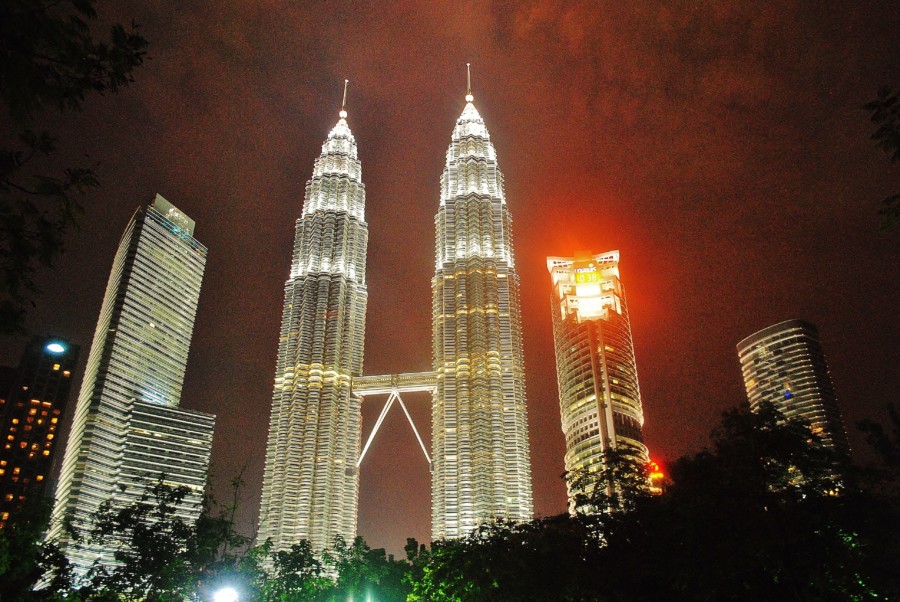
The national mosque of Malaysia, Masjid Negara, which is one of the largest mosques in South East Asia. From the outside, the building looks really huge, it stands on a large marble square and is surrounded by fountains and several palm trees. I prefer smaller objects anyway, so I definitely prefer smaller and more moody Masjid Jamek. Masjid Negara is a huge body that I wanted to get but I came in the wrong time. Catholics let in only between 3 and 4 pm so I forgave myself, especially since I was already in many mosques and probably in many more I will.
Right behind the Masjid Negara mosque is the Old Train Station, which looks like a piece of architectural art in Islamic style. The station is white and has characteristic gates and accessories. I recommend as a good object for photography.
In the Golden Triangle:
Firstly, to get there, take the LRT and get off at KLCC (only 3 stops from Chinatown). Metro arrives straight to the “dripping rich” shopping mall located at Petronas Towers.
►The symbol of Kuala Lumpur city and the whole of Malaysia are the Petronas Towers. Inside the hotel there are a number of wealthy shops with prices causing nose bleeding, but made me feel bored, as these places do not belong to my interests. After a short while I went to the big terrace and there I saw twin Petronas Twin Towers close up, with their tips pointing up to the sky. Petronas Towers are 452m long and have taken up five years of planning and construction. They have 88 floors and between the 41st and 42nd floor is the bridge connecting the two towers. From the outside, they are designed in such a way that geometric patterns are characteristic of Islamic architecture. Over the years the towers in KL were the highest in the world, but in 2004 in Taipei, Taipei 101 was the tallest building in Taipei, reaching as high as 509 m with 101 floors, and then in 2010 Burj Khalifa was built in Dubai with 828m and 160 floors. The square on which the towers are located is very clean and well maintained. There are several shallow pools in which children bathe (and me too) and a couple of fountains. These pools are a very good idea in a hot tropical climate as people can always wet. There is also a large metal sculpture depicting a whale popping up from the pool, around the well-tended gardens with exotic vegetation, a pond, a children’s playground and, of course, a rich shopping center. I spent most of my time in the shade of the palm trees and in the pool watching the towers. Petronas Towers are unique and on every side there are a lot of people trying to fit in the whole building. At night, the towers are clearly illuminated, which makes the presence of a completely different experience after dark.
►Another attraction I saw was the Menara Kuala Lumpur, which is 421 meters high. At 276m there is a restaurant and a rotating viewing terrace, from which you can see Petronas Towers and the whole area. In Menara KL I met a very pretty girl from Germany in a short skirt with whom I spent the rest of the evening. First we went to the Animal Zone downstairs. There were a lot of reptiles, but that monkey and some big parrots. Animal Zone is included in the price of the ticket. Then we went to the Petronas Towers and then back to Chinatown near Petaling.

(Zawsze podróżuję sam i tylko od czasu do czasu spotykam kogoś w drodze z kim jestem przez jakiś czas. In my experience I have the best contact with German and French women, not a good one with Dutch and the worst with English women who I avoid like fire. I can not complain about the Swedes either. However, wherever I go I always have very good contact with Americans and as I noticed, in a funny way they like Poland.
Kuala Lumpur very much enjoyed it and I believe that in the Malaysian capital you should stay at least two full days. At the end, two Germans took me to the night bar just before leaving. Interested in I recommend also museums and art galleries, from which Kuala Lumpur can be proud.
Batu caves
Batu caves are a close encounter with Indian culture and with Hinduism, which I admit is a nice experience. There is a large cave inside the mountain, which leads to 272 stairs, and faces a huge golden monument of 43 meters Murga (Hindu figure). There is also a pond with fish and swans that can be fed, and in my opinion one of the biggest attractions is yet another cave. In one part there are figures and bas-reliefs of Hindu saints in many interesting positions, and in another part there is a reptile cave. There were many snakes, some lizards, lizard turtles, small cobras, iguanas and several large tiger python. I played with small grid python and reminded me of the snakes I kept in my house. Finally, I went to an Indian restaurant for a small snack.
Batu Caves I would highly recommend as a very comfortable tour of Kuala Lumpur. The whole property is 13km from KL and the fastest shuttle is a train from Chinatown to Batu Caves, although there is also a bus and of course a taxi. The bus costs about RM2-3 and the ride takes 45 minutes.
The one-day trip from Kuala Lumpur (about 45 minutes by bus) is Genting Highlands, but I chose Cameron Highlands instead. This is a good option for those travelers who do not have much time and want to see something different than just city and beaches.
Transport from Kuala Lumpur to Cameron Highlands
The bus ride lasted 4h and I paid RM28. I reached Tanah Rata, the tourist center of Cameron Highlands. The last phase of the ride was tiring because the bus was weak and it was driving slowly up the hill.
I also note that the bus station in Kuala Lumpur is located in Chinatown, 5 minutes walk from the Petaling Market.
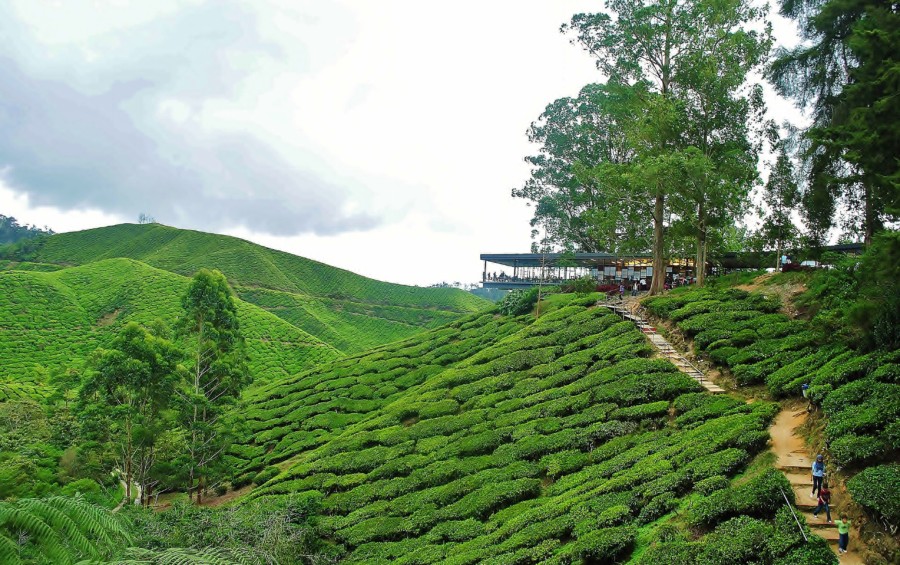
Cameron Highlands
Cameron Highlands is an upland area of natural beauty, including green mountains covered with dense jungle, nice views, strawberry fields and tea fields and waterfalls. For someone who comes here from the hot areas of Malaysia, Cameron Highlands is relieved because the average temperature is here from 10 to 21ºC, and it also comes with pleasant cool rain and fog.
There are many small towns in Cameron Highlands, but the main one is Tanah Rata, which is a very good hotel and where there are many great restaurants. I especially recommend Indian restaurants, which is the most. Besides, it is not only well and pleasantly but also very cheap as for the bed at the Kang Guesthouse I only paid RM12 and for a great meal at an Indian restaurant only RM8. Tanah Rata is a small, pleasant, mountain town and can be reached in half an hour. I recommend a small playground with a fitness area surrounded by vegetation. It is a very quiet, pleasant place.
The next day I set out for a day trip. First I took the bus about 16km as I remember and got off the police station. Here I followed trail number 1 towards Gunung Brinchang (2031m n.m.p.m.), which is the highest peak of Cameron Highlands. All climbing took me about 2h and it was fun because the whole mountain was covered with thick jungle. Besides, it was not easy because it was raining and I got into the mud a few times. I also had to avoid the broken trees and catch up on what I could to get higher and higher. Then I went to the tower from which was a nice view of the countryside. In conclusion, however, it was best to climb to the top because the adventure with her was unique. Then I went to the moss forest, which in my opinion is a unique place. Because of the great humidity, all the trees are covered with moss at a distance of hundreds of meters. The moss forest for tourists is not large and can be easily seen by walking up the stairs, but when the stairs end, the next trail to another peak. I walked this route about 2h uphill and I admit it was even better than before. There were not only moss-covered trees, but also small marshes, exotic plants and insectivorous flowers. The thick jungle gave me a great impression. I add yet that the immense humidity made many trees were broken along and with many hanging down moss.
At this point I met a traveler from Italy, and together stopped in some places we headed to Tanah Rata, 16 km away. After a few hours of walking we got to half the tea on the green hills and stopped here several times to take pictures. The path we followed led to the Boh Tea Plantation, which is the largest in Malaysia. So we sat down in the restaurant with a viewing terrace and had a tea tasting from the nearby bushes. It was very nice because the views were beautiful and after the rain over the fields a fog appeared. The tea, of course, was very good. Then we walked the asphalt road and came to such places as, for example, strawberry plantations, which in Cameron Highlands are very widely cultivated. I also saw the cactus and the garden of butterflies. We were also on a cheap meal by the road. Malaysian burgers are very popular in Malaysia for only RM2. In the further way I saw the Chinese and Hindu temples, the golf course and the town of Brinchang. After returning to Tanah Rata I sat in a playground surrounded by nature and ended this day visiting the Indian restaurant. I admit, however, that the 16km walk and the climb made me so exhausted that day. In addition to Tanah Rata, I also got wet because of occasional rain. Fortunately the hostel was a warm shower. Cameron Highlands is a beautiful place but the tourist needs effort.
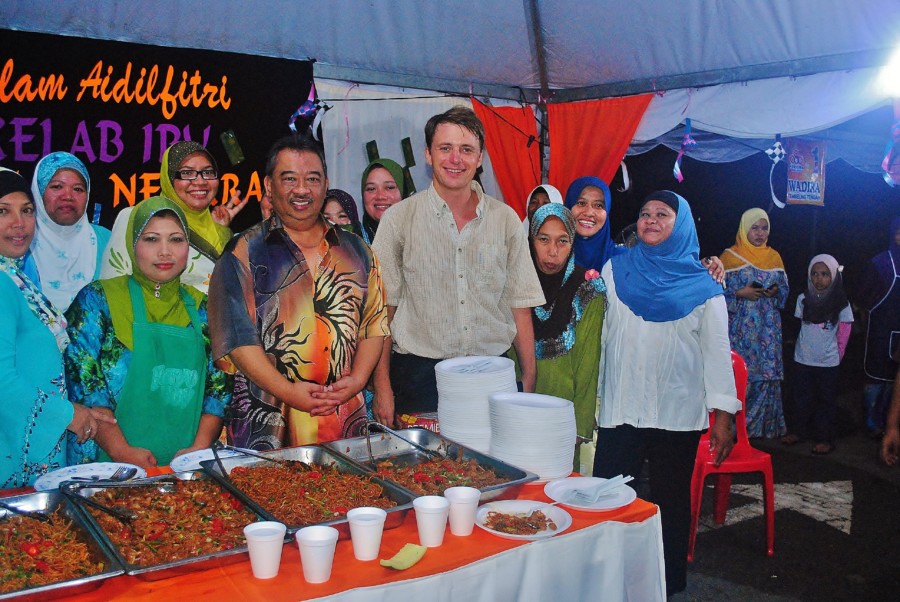
Tanah Rata also has a number of travel agencies that can take travelers to the surrounding area for a small price. I recommend here primarily waterfalls and the largest flower of the world, Rafflesia. But first you have to know if it is blooming. The trip is definitely easier though and you have to go over the jungle. However, I traveled on a very low budget and therefore all tours organized myself alone which is always harder to plan and heavier. On site you can find out how to reach yourself to some places.
Transport from Cameron Highlands to Taman Negara National Park
My transportation to the best western Malaysian national park was adventure. First I took a bus to the small town of Jerantut, which took me 4h. Then 20 minutes to the town on the river called Kuala Tahan, where I bought a permit to enter the park. Then the whole group sailed narrowly across the whirlpools and jungles to the tourist center of Taman Negara, the small pleasant settlement of Kuala Tahan. The whole ride cost me RM55.
From Jerantut you can take a direct bus to Kuala Tahan which is much cheaper and the ride takes less time but I would recommend the boat as it is a very pleasant part of our adventure. Bus recommended on the way back to Jerantut, through oil palm fields.
Taman Negara National Park
Taman Negara is the largest national park of Peninsular Malaysia and covers an area of 4344 km². This is a beautiful area covered with dense jungle, where conditions are very heavy due to heat, humidity and marshes. The jungle has many unpleasant surprises for us in the form of very difficult terrain and wetlands during the rainy season. Taman Negara is also home to the original forest and many species of exotic animals. You can spend the night in the cave, take a bath in the wilderness and spend long hours in detachment of leeches. Anyway, it is a wonderful, unforgettable experience in nature that I highly recommend. In general, Malaysia is a country of beautiful nature and there are many jungles, lianas and spectacular waterfalls in the country.
I got a boat ride to a small, pleasant village on the river called Kuala Tahan, which serves as the park’s board and where you can sleep in bed. I had a bed in a 4 person room for only RM10, although it was a cheap price. On the first day I spent time alone exploring the Kuala Tahan river. On the shore are also drifting pubs where you can spend the evening in the company of mosquitoes and where they release a documentary film about Taman Negara. The same evening there was an open-air event where all food and drinks were free because the king of that state had arrived. It was very nice and the Muslims with their heads wrapped up like Christmas presents served me food. In Kuala Tahan itself there is nothing to do, so that evening I organized a trip to the jungle for two days and one night for the magical sum of RM200. There were those who paid around RM250 that’s why I felt I had won. Unfortunately, to experience the beauty of Taman Negara, you need to prepare a bigger budget.
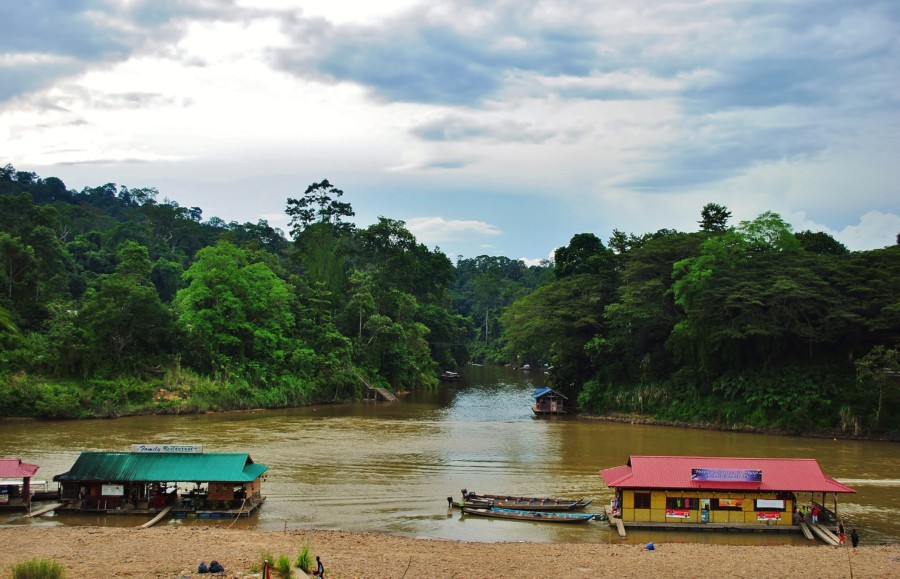
The next morning I went on one of the expeditions of my life and as soon as I set off I did not pity the RM200. It was very adventurous and beautiful but also a difficult expedition. First, we sailed by the river. The fun was better that the places were very shallow and scrubbed over the rocks, although there were also river vortices which is always a great attraction. We drove 8km a day through the dense jungle and wetlands. There was heat and huge humidity, accompanied by leeches and mosquitoes and several times each of us fell into the mud. We spent the first night in a cave with bats hanging over our heads. We slept in sleeping bags and mats which meant a hard but adventurous night. At bedtime we talked at the fire, also in the cave, and I told the women about the venomous snakes and the phantoms that prowled at night. But they were clamoring for their breasts, fearing terrible. The next day we went another 8km. This time the jungle and its huge trees with great roots were the same, although we crossed the river several times, balancing on it a thin stick. This was, of course, a makeshift bridge that proved to us that it would be better to jump to the mud. We also had a modest dinner on the water-bordered promontory, and then had a repeat of Laos. I swam in the river and jumped to her hanging on the rope. After the next hour of marching, we reached the mainstream of the river and again bathed while waiting for the boat. Then once again by the river whirlwinds we returned by boat to Kuala Tahan. On the way we also stood in the primitive village of Orang Asli where the houses were thatched and very ugly black people. But for the first time, I shot a long bamboo shoot, which locals use to shoot down trees.
The jungle trip to Taman Negara Park was wonderful and I think it must be done. I also recommend walking on a wooden bridge accosted to huge cannabis, but I did it in another park on Borneo.
Transport from Kuala Tahan (Taman Negara) to Jerantut
Route very old bus led through palm fields. The ride to the station at Jerantut lasted 1h and cost me only RM7.
Malaysia is the second largest palm oil producer in the world and accounts for 44% of the world’s exports. On the way I saw the big palm trees and beside also the trucks with oil.
Jerantut
Jerantut is a small, uninteresting town that is the base for Taman Negara Park. I stayed here one night and one day to do laundry, go to the bank, eat some good food and take advantage of the cheap internet. Behind the hostel I paid only RM8 which is a record low.
The Gelangan Cave is in the area but I did not go because I would have to pay for the RM60 taxi, which is profitable only in the group. Buses only go there theoretically.

Transport to Perhentian islands
From Jerantut I took a bus to Kuala Besut, which is a base for the Perhentian Islands. Riding a small busik took me 6h and paid RM58, and on the way we stopped for dinner. Boat trip to the island is expensive because for half an hour boat cruise I paid RM35, what experience I know is the standard price for transportation to any of the islands.
Any shopping I advise to do here because Perhentian is much more expensive.
Perhentian islands
The Perhentian Islands have the most beautiful beaches and the most turquoise waters of all the fabulous places of Western Malaysia. There are many wonderful white sand beaches, coral reefs, and great diving and relaxation options. In the middle there is also a small jungle and on the beaches a few bars and cheap rooms. Although Perhetian is more expensive than the rest of Malaysia, prices are within reasonable limits (except for the internet) because local people living on Perhentian also cost a lot more. Pulau Kecil (small island) and Pulau Besar (big island) are covered by the Pulau Redang National Marine Park, and it is so beautiful that when it seemed to me that I had nothing to do, it was great because nature was delightful.
I stayed on the smaller island of Pulau Kecil, which is cheaper than Pulau Besar, because the small island is for backpackers and large for people with larger wallets. For a bed in a multi-room I paid RM15 and a meal on average RM10. Perhentian was still low prices. To Perhentian island, on Long beach I arrived in the evening and on the first day I just dived and came on the beach. There is no lighting here because electricity replaces generators and torches and the whole island is very quiet. Still, there are two bars on the beach where the party lasts until midnight.
Next day around 11am we set off on a boat trip for the RM40. It was beautiful and the views were wonderful although unfortunately the sun burned me a bit. This day was a show of warm turquoise water, beautiful palm trees and colorful fish, although there are some specific places I visited and which every traveler should see here.
They were:
►Turtle point; I dived with a huge sea turtle, who had grazed the grass off the bottom. It was a truly beautiful view, to see a sea turtle in its natural habitat and graze on the bottom. Once in a while the turtle emerged to the surface to take a breath and then returned for a meal. To his back were implanted fish.
►Coral garden; I dived here with a mask and a tube among the coral reef and its coral fish.
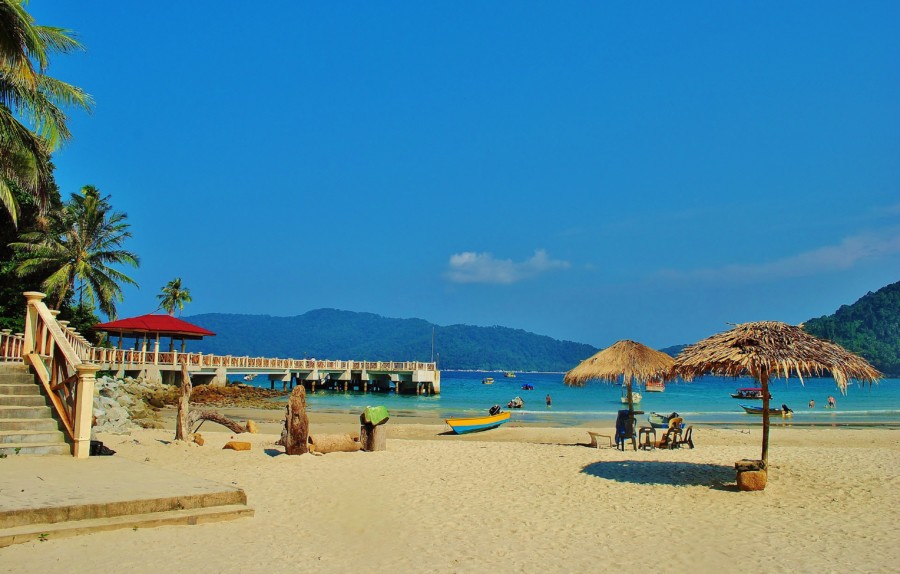
Perhentian islands.
►Shark point; same as above but only here I saw small black tip sharks. There is nothing to be afraid of.
►Then we had dinner at the fishing village. I was given a fish and I was sitting under palm roof and looking at the turquoise ocean covered with sun and palm trees. The service was exceptional free but the views and the beautiful island itself.
►Fish point; I also dived here to watch the fish, although some were large and bitten the rocks with their mighty teeth. Another nice experience under water.
►Turtle beach; Nice beach with a wreck of a boat and a stream of fresh water. Apart from white sand and palm trees, there was also a fence with a nest of sea turtles.
After the trip I slept because the sun knocked me out and I left only after dark. I went to the other side of Pulau Kecil and watched a movie on the terrace by the sea. Beautiful, cheap, great views after a meal of exotic fruits.
My last day I avoided the sun so I found a shady spot under the pier and there in the warm blue waters I spent the whole day. I also looked for nice shells and watched colorful fish.
Staying on the Perhentian Islands was a wonderful experience which I would certainly recommend as a short stay in paradise.
Transport from Perhentians to Penang island
First I took a boat to Kuala Besut (half an hour for RM35) and then a small bus to Penang. This part of the ride took 6h and I paid RM55. But be careful because there are many lurking in the harbor who want to sell tickets for much more. You should go straight to the office and do not talk to anyone because it will be more expensive.
Malaysia Peninsular is connected to the island of Penang by bridge, so you no longer need to pay extra RM35 for the ferry.
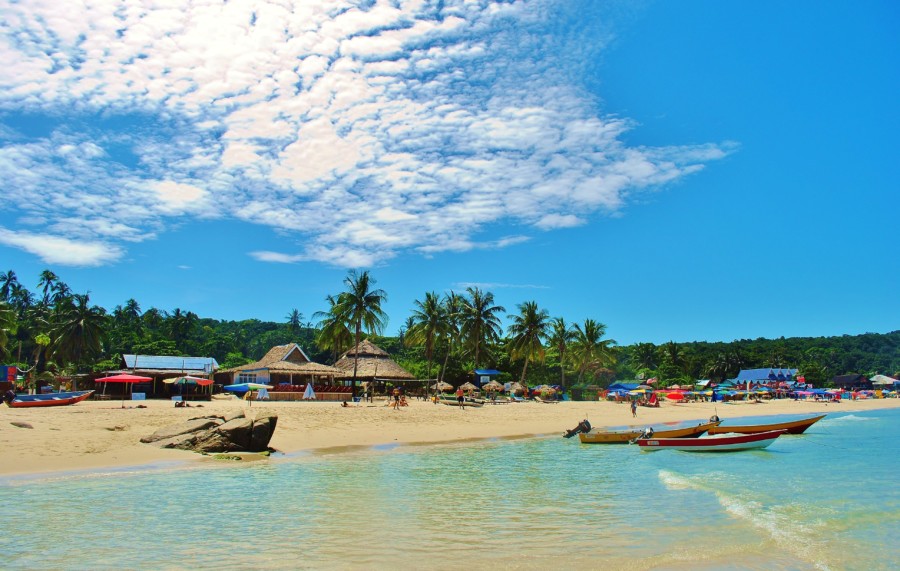
Perhentian islands.
Penang
Penang, in my opinion, is one of the most interesting Asian islands, which, alongside Singapore or Hong Kong, was one of the largest ports and business centers in Britain. The strategic location of Penang has made Penang a small fishing village, visited by merchants from China, India and Europe, which has led to the economic success of the island. Today Pulau Penang is dominated by businessmen from China, although there are of course Malayas and Indians, whose restaurants I highly recommend. Other islands like Perhentian or Tioman are attractive because of the natural beauty, while Penang recommends lovers of diverse cultures and good cuisine.
Georgetown
The main city of Pulau Penang is Georgetown where there are many interesting sights and a nice promenade by the sea. Georgetown is also many historic streets with old houses, Chinese and Hindu temples and Indian restaurants with very good food. I stayed in Chinatown where the bed in the dorm room at Love Lane paid only RM8. The first night was loud but each and every one was better.
The next morning I took a shower in the attic and left for a tour of Gorgetown. First, I strolled down the streets of Chinatown trying Chinese food from local stalls, then Little India, until I reached the coast. On this day I saw the following objects:
►Leaving Love Lane after a short time on my right hand appeared a great mosque named Captain Keling, who has one minaret and nicely decorated interiors. Besides, Captain Keling’s mosque is in the garden, has a nicely finished interior and is in a white color. In general, this is an attractive property that is best seen from afar, although I recommend going around.
►Following the same path I reached the beautiful nineteenth century Chinese temple called Khoo Kongsi (clean house). This is a very well-tended temple building rich in dragons, statues of saints, wall paintings and colorful tiles and a profiled Chinese roof. Khoo Kongsi was built in 1906 and served as a temple and as a meeting place for Chinese people from the same clan. It is a beautiful and very interesting building requiring exact exploration, which can not be missed.
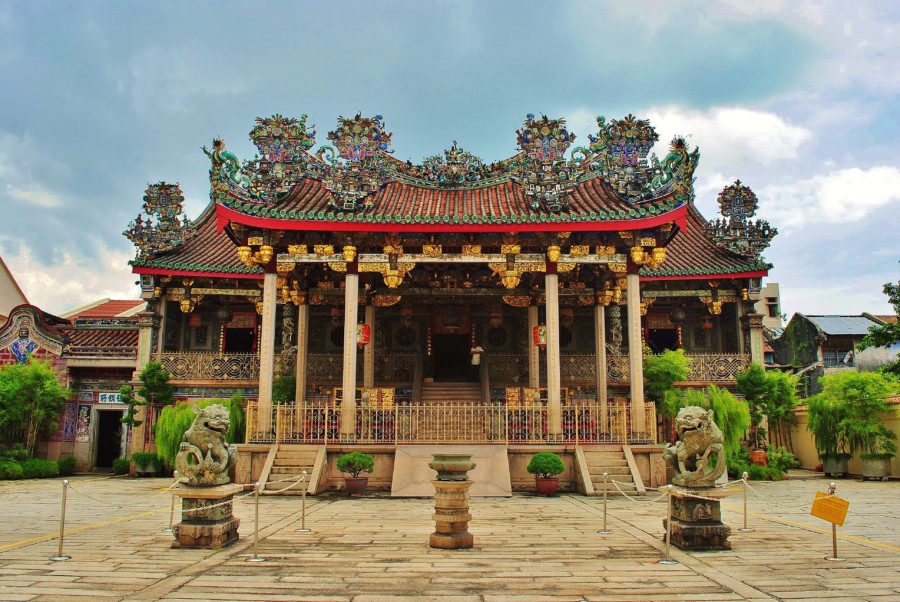
►Then, returning to the left and having the Captain Keling Mosque, on the right at the corner I went to another Chinese temple called Han Jiang Teochew. It is located on the main street, and the entrance is covered by large wooden doors and a white wall and profiled roof with colorful tiles. Inside are walled murals, Chinese inscriptions, and a roof with dragon figures. This temple is a typical Chinese experience, and its construction was completed in 1870.
►Then I went to the nearby famous Penang Chinese temple called Kuan Yin Teng, dating back to the early nineteenth century. This is another interesting object with many paintings and sculptures referring to the philosophy of the Far East. The temple of Kuan Yin Teng is not as architecturally excellent as the Khoo Kongs, but gives a much better chance of observing people during their prayers and religious rites. It is also one of the few places where paper money is raised after the wind. Khoo Kongsi was a temple that served as a great museum of art, while in Kuan Yin Teng we experienced how people approach Buddhism.
►Then I went to Little India, which is right next to Chinatown. There are many stalls with Indian food and fine restaurants serving good naan, tandoori and tika. The selection is huge and the food is outstanding. I recommend here Restoran Captain and Kassim Mustafa. I also visited stores with Indian music and sat down in the rain on a street stall, always a good cup of Indian bottled water. There is also the Sri Mariamman Hindu temple (the same name as this one in Singapore), which is a typical Indian culture object. There are many statues of very original Indian gods. This temple was built in 1883 and is the oldest Hindu temple in Goergetown.
►Then I reached the coast where fishermen were fishing behind the bus station. Next to it was a nice Padang garden and the City Hall, housed in a white house with pillars. In this part of the city, I went to fort fort Fort Cornwallis, built by Captain Francis Light in 1786. It is an interesting fort surrounded by a wall with several cannons, a monument to the captain and chambers where we can read about the history of this facility. Then I went to the Penang Museum, which very well illustrates the history of the island and its technological development taking into account various racial-cultural communities. I also recommend the Perenakan Mansion, especially those who were not in a similar house in Singapore, and the Cheong Fatt Tze Mansion, a blue hotel built by a Chinese merchant in 1880.
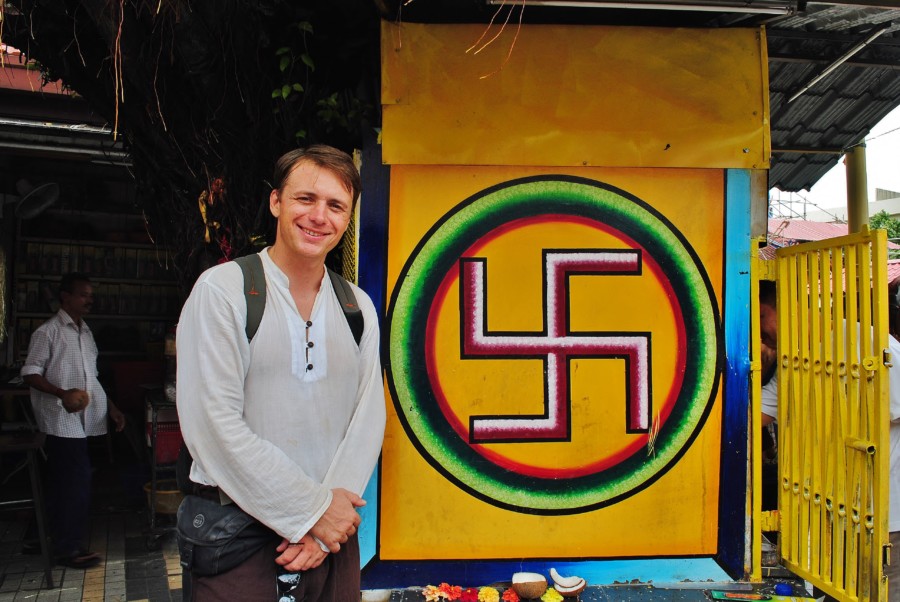
On that day I went on to Georgetown, sometimes settling down with the Hindus on the bottle and the Chinese on duck rice. I spent the whole day touring, although later I saw these ames many times as Georgetown was my base for many days on Penang.
Interesting objects outside of Georgetown
At first I want to say that Penang has a very well developed bus network and there is no problem in getting to many interesting places on the island. From the center of Chinatown in Georgetown you should get any bus to the station at Komtar Complex, and from there you can get to every corner of the island for little money.
I went for example to Penang Hill (821m), which turned out to be a very nice adventure even during the rainy season. First I rode up the hill, but only one way. It was raining on the day so the views of Penang were certainly beautiful, although I saw only the mist. But I liked the nature, the palm trees and the big red and orange flowers. I was also in the only pub on the edge of the mountain to have a cup of tea, and then I went among the greens to the Bird Garden. Here, in large cages, there were exotic birds, such as various species of parrots. Some of them completely ignored me and others wanted to play, whistle and try to make me laugh. The whole area was so nice that the cages were surrounded by vegetation and a warm tropical climate, although it did not burn the sun. Penang Hill was also a Hindu temple and a mosque, but I was interested in them. Nature is definitely the best asset. Then I went down on the asphalt, twisted road and the distance about 6.5 km I beat in 2.5h. If anyone wanted to climb to Penang Hill it would take 5h. On the way down I saw monkeys and exotic nature. Sometimes I also stood under palms or in bamboo orchards to hide from the rain.
After a pleasant and wet march, I left the Botanical Garden where I spent another hour. It was an open green area with many palm species, where I saw bamboo orchards, a waterfall, spectacularly fallen trees incorporated into the rocks, and of course the monkeys that live there. I also recommend an orchid garden and spice garden. In the area of the waterfall there are also many huge trees with large roots protruding high beyond the surface, which gives a very affective view. The Penang Botanical Gardens were founded in 1884 as a continuation of this custom in nearby Singapore. This is an exceptionally beautiful, secluded place that I would heartily recommend, although in some seasons only with an umbrella. After leaving the gardens I met two travelers, a man from Finland and a young Lithuanian woman. Because there were no buses that day, we drove costs and drove together to the beautiful and largest Buddhist temple in all of Malaysia, the temple of Kek Lok Si. This temple, built on the hill of Air Itam, was built from 1890 until 1910 and was mainly funded by the faithful. At first I went through the bazaar where I sold clothes mainly until I got to the souvenir shops and figurines related to Buddhism. In the meantime, I was also in a place where there was a fairly large, circular pool with turtles and waterfalls and a small pagoda in the middle.
Next there was a larger square where there were many other temples and smaller chapels, and all were richly decorated. One of the temples was also the 30-meter Pagoda of the Thousand Buddha Ban Po Thar. In the middle of each of the temples there were statues of saints, Buddha and dragons, although my attention was also tiled with hand-painted Buddha. At the end I took a turn and went to the highest point of the temple, where was a 36.5 meter monument Kuan Yin; goddess of pity. This is a huge monument built of bronze, which is visible from afar. The temple of Kek Lok Si was magnificent and it is another mandatory property of Penang. Unfortunately the view from the street spoils the apartment block, which by the beautiful temple is a mere architectural rubbish. After all, I was in a Chinese pub with a small rice snack and jasmine tea.
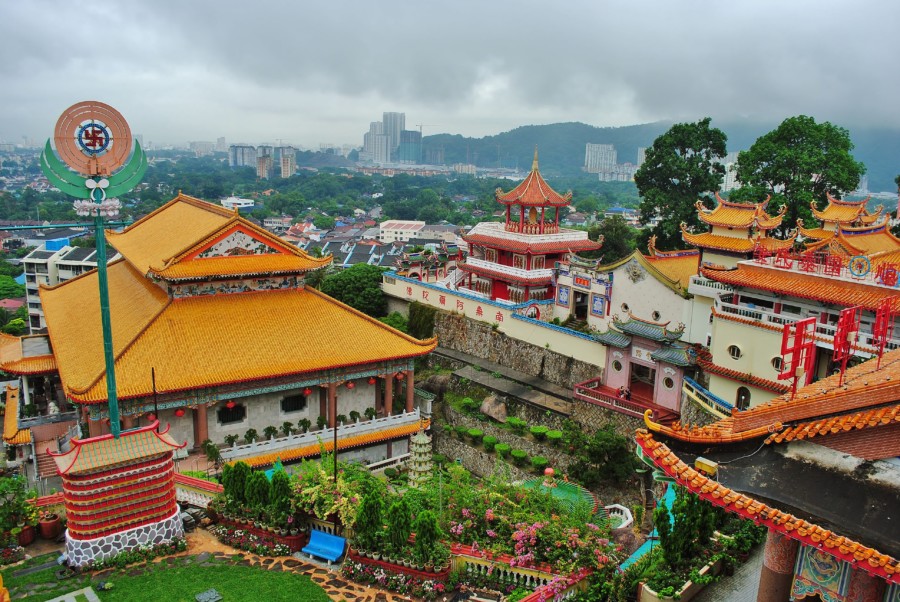
On the other day I went first to the Floating Mosque, which is a very attractive mosque built on a pier by the sea. From an architectural point of view it is very nice and well integrated into the surroundings. Also I recommend going around it because the view from the terrace is very pleasant. I spent the rest of the day on the beach “decorated with large boulders, sipping Malaysian tea and eating fried bananas. I was very well here.
The next day I went to the popular Batu Ferringhi beach, which is the most popular beach on Penang, although in my opinion Western Malaysia has no better spots in the east. At Batu Ferringhi there are many expensive hotels with swimming pools and the whole area is well-manned. Hard Rock Hotel is a well-known place, as well as a restaurant and shop with the same network. Besides, there are many food stalls and a nice bazaar with souvenirs. It is a good place to buy gifts for your women after a long break. Batu Ferringhi can be reached from the Komtar Complex by bus 101 or 105 and the ride takes about 40 minutes. I spent the evening at Goergetown in a Chinese neighborhood with mango juice and then went to the airport. I had a night flight from Penang and for a taxi I would have to pay about RM30 because the buses were gone. However, I managed to get to the place by hitchhiking, which I always recommend in Malaysia. I soon flew to Malaysia’s Borneo, and my goal was Kuching in Sarawak. It was the end of my wonderful experience with Penang and the beautiful West Malaysia.
Summary of Western Malaysia
Western Malaysia was very interesting because it is a combination of cultural richness and beautiful nature. Western Malaysia (peninsular) is the heart of the country that brings the rhythm of Malaysia all the way. In the western part I spent almost a month and all the above described places I would highly recommend. I can not imagine a tourist not to see such cultural sites as Kuala Lumpur, Melaka or Penang, and the wonderful nature of Perhentian or Pulau Tioman. Western Malaysia is a beautiful country where everyone can find something for themselves. The food is also very good and varied.
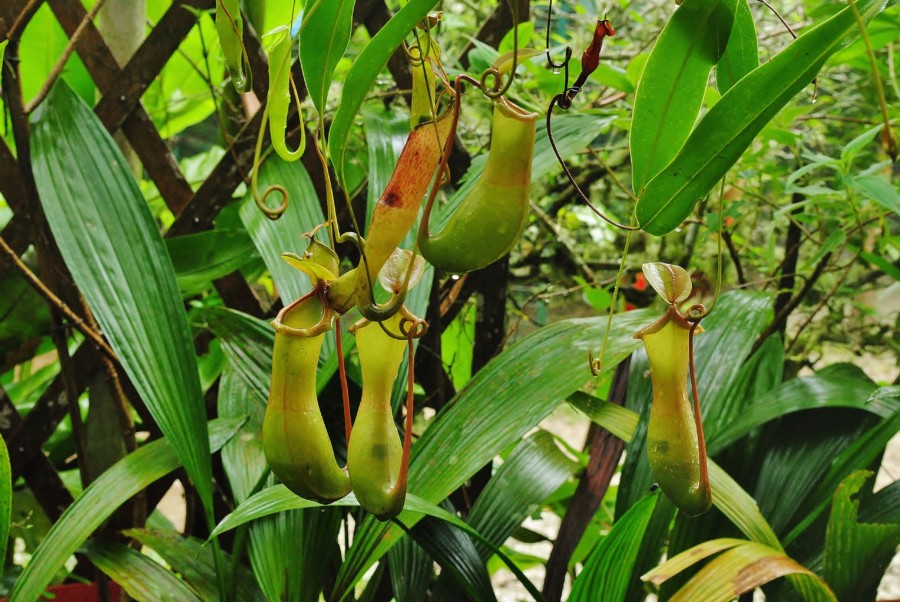
- Batu Caves
- Cameron Highlands
- carnivorous plants
- insect eating plants
- Johor Bahru
- Kek Lok Si Penang
- Kuala Lumpur
- Little India Kuala Lumpur
- Masjid Jamek Kula Lumpur
- Melaka
- Menara Kuala Lumpur
- Merdeka Square
- Penang food
- Penang Island
- Peninsular Malaysia
- Perhentian Islands beaches
- Petronas Towers
- Pulau Tioman
- Sri Mariamman
- Taman Negara Park
- West Malaysia



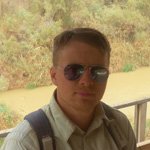
































Lucas
I like the way you write. I’ve found a lot of useful information! Thanks. Have great travels!!;)
Kate
Great travel report, thank you. Good luck and all the best.
~Anne
Great journal, and very informative;) Very useful because I’m going to all those places soon!